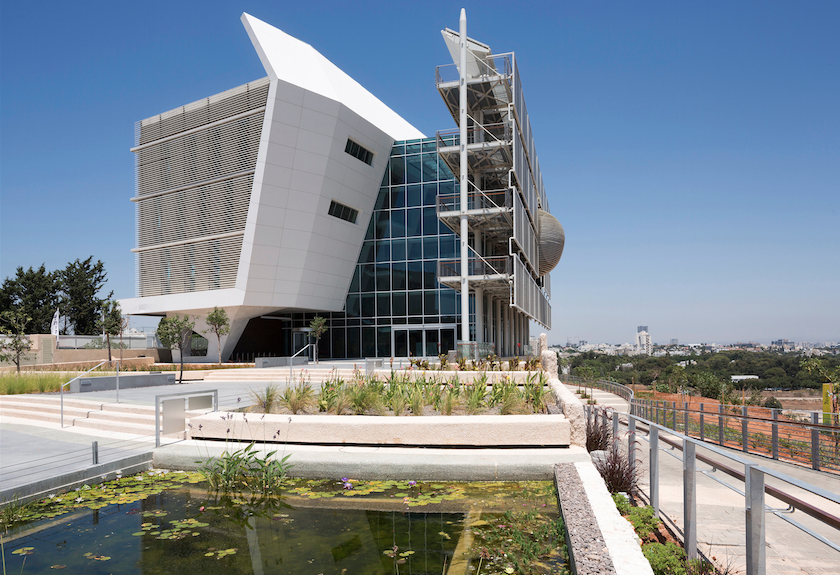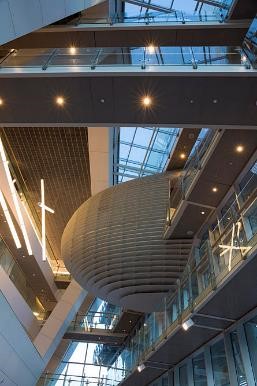Code Green Solutions


The Porter School of Environmental Studies was founded in 2000 with the generous support of Dame Shirley Porter. It was founded as a response to the growing demand for research specifically dedicated to the multifaceted characteristics of environmental issues.
In 2007, an architectural competition was announced with the intention of creating a physical home for the developing school: a home that would in itself be an example of applying the interdisciplinary and results-guided creativity advocated by the school, as well as being a platform for further ground-breaking research in environmental science and in green buildings in particular.
Seven leading architectural firms and work groups reached the final stage and the Axelrod Grobman Architects, Geotectura studio and NCArchitects design was selected as the winning proposal. Braudo-Maoz Landscape Architecture were charged with the landscape development and were joined by several other project partners: Assa Aharoni Consulting Engineering Ltd., Avivi Axelrod Engineers Ltd. and the Baran Engineering Group, which managed the design and construction. Building design commenced in 2009, project construction began in late 2011, and the project was completed with the support of the Porter Foundation in May 2014, receiving a world-class LEED Platinum rating of 92 points in November 2014.
The PSES building was designed as a living laboratory demonstrating green building and environmental technologies and enabling further research in the field. The building, constructed on a south facing slope, harnesses its solar exposure via thermo-solar collectors. These, connected with an absorption chiller plan, provide most of the energy required for acclimatizing the building. With natural light and ventilation inherent in the design, the building’s energy footprint is reduced to a minimum. Design provisions for acoustics, fresh air and occupant control adhere to the highest attainable standards, while storm water management, a green roof and water purification plant address broader environmental issues. All materials are sourced from environmentally controlled processes, recycled raw materials or renewable natural resources.
The capsule, an egg-shaped element representing the planet earth, visible from the main façade of the building and facing one of the busiest highways in Israel, is designed as a reminder for the people using the building of the values the school is aiming to preserve.
The building was designed over a site in need of serious remediation: the slope, overlooking a major polluting highway, was an illegal dumping ground for construction debris of university buildings in decades past, making it unstable. Actions were taken to remove contaminated soil but leave and reuse as balance fill suitable soil. The site was connected to the national train system 200 meters down the road via a pedestrian and bicycle promenade. Consequently a decision was made to forego underground parking and to use the funds to construct an auditorium instead; only a few guest and handicapped parking spots were provided aboveground, and the balance of parking needs are provided via other parking facilities in the university.
Landscaping and infrastructure were harnessed to stabilize the storm management, incorporating a holistic water management plan that includes graywater collection and purification via natural septic pools.
A direct and easy connection to the bike path from the train station and main roads was designed and bicycle showers and roof-covered parking is provided.
Extensive research has been undertaken to reduce the ecological impact of the project and to produce minimal light pollution. Extensive measures have been taken to ensure construction process practices adhered to environmental goals and would produce the expected environmental performance.
All the water used in irrigation comes from storage of rainwater or from naturally remediated grey water. All fittings and fixtures are designed to reduce water use and monitor water usage from various sources for all building needs.
One of the key elements in the building is the EcoWall.
It serves several purposes:
Additionally, the computer-controlled network of LED bulbs, surfacing the capsule, enables the presentation of environmental data at some distance, to be observed by passersby and highway passengers. This approach of educating, sharing and providing accessibility to data – strikingly uncharacteristic of the competitive world of research – best represents the spirit of the Porter School of Environmental Studies and its building.
The building was specifically designed to demonstrate groundbreaking energy performance. Demand reduction started with the physical design, moving the habitable to the north side away from unwanted solar radiation, open to quality northern ambient light and away from highway noise, enabling window opening and natural ventilation. High efficiency, mostly solid-state artificial lighting, automatically coordinated in real time with natural lighting, reduces electricity demand and internal heat gain to a minimum. The building structure is whole concrete with high thermal mass and heat capacity, allowing it to warm up during the winter and release the heat gradually.
The atrium space excess heat is released via thermal chimneys assisted by aerodynamic shaping of the southern facades with fan backups. The space is acclimated via radiant heating/cooling coils placed on its heavy thermal mass concrete floor and cold air blowers just above head level.
The building AC system uses cold water generated via an absorption chiller fed by hot water coming from the EcoWall’s solar collectors. Hot water when needed is provided directly from solar collectors or from a backup gas heater. Cold or hot water operates high efficiency chilled beams and radiant floor coils. Fresh air supply is generated through a heat exchanger allowing the system to supply adequate fresh air without compromising energy efficiency.
An interesting anecdote is that the first municipal review of the electrical connection returned saying that the connection requested for the building size was inadequate and the designer must have erred in their calculation. Actual installed connection was even lower.
The building interiors have been fitted with a multitude of recycled, renewable and reused building materials; but everything, including all adhesive, sealants and paints has been checked and approved for low VOC content. Careful analysis has been done to reduce solar gain, glare and discomfort associated with the position of the sun.
The building continues to be a center of environmental stewardship and learning, and the building team is collaborating to further expose this, such as in the augmented reality initiative:
Arki-PSES application showcases the underlying environmental strategies in PSES in real time through several interactive features. Animation demonstrating sun path, wind circulation, lighting strategy, mechanical strategy, sustainable material strategy, program strategy, and environmental skin applied over a geographically oriented 3d model of the building, separated into layers to highlight specific components.
Guided tours of the building present green building principles to various audiences: architects and other professionals from the field of planning and construction, architecture students, schoolchildren, and people with a general interest in green building. The tours provide information about the planning principles of the building, the green architectural elements and the integrated technological systems.